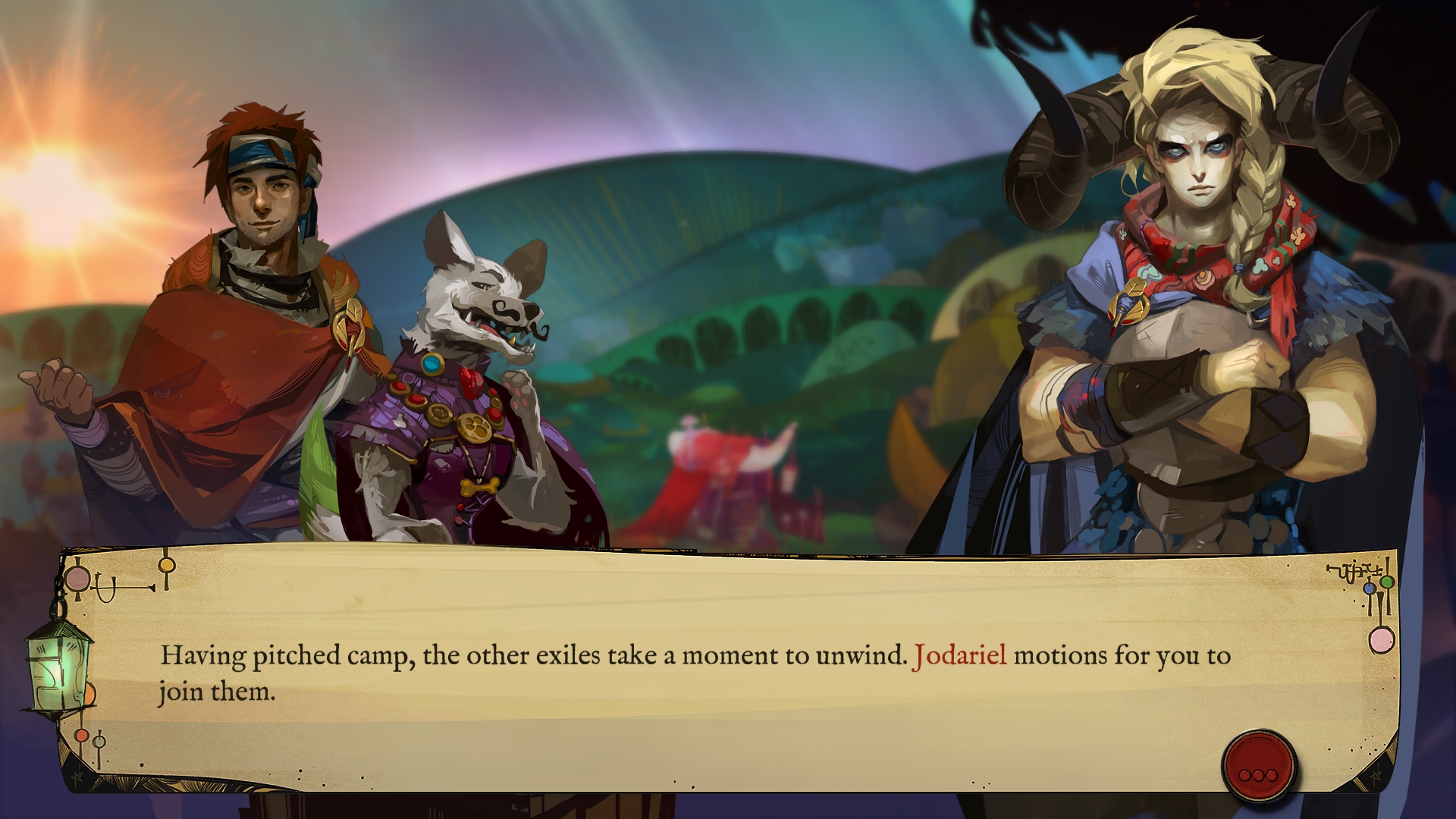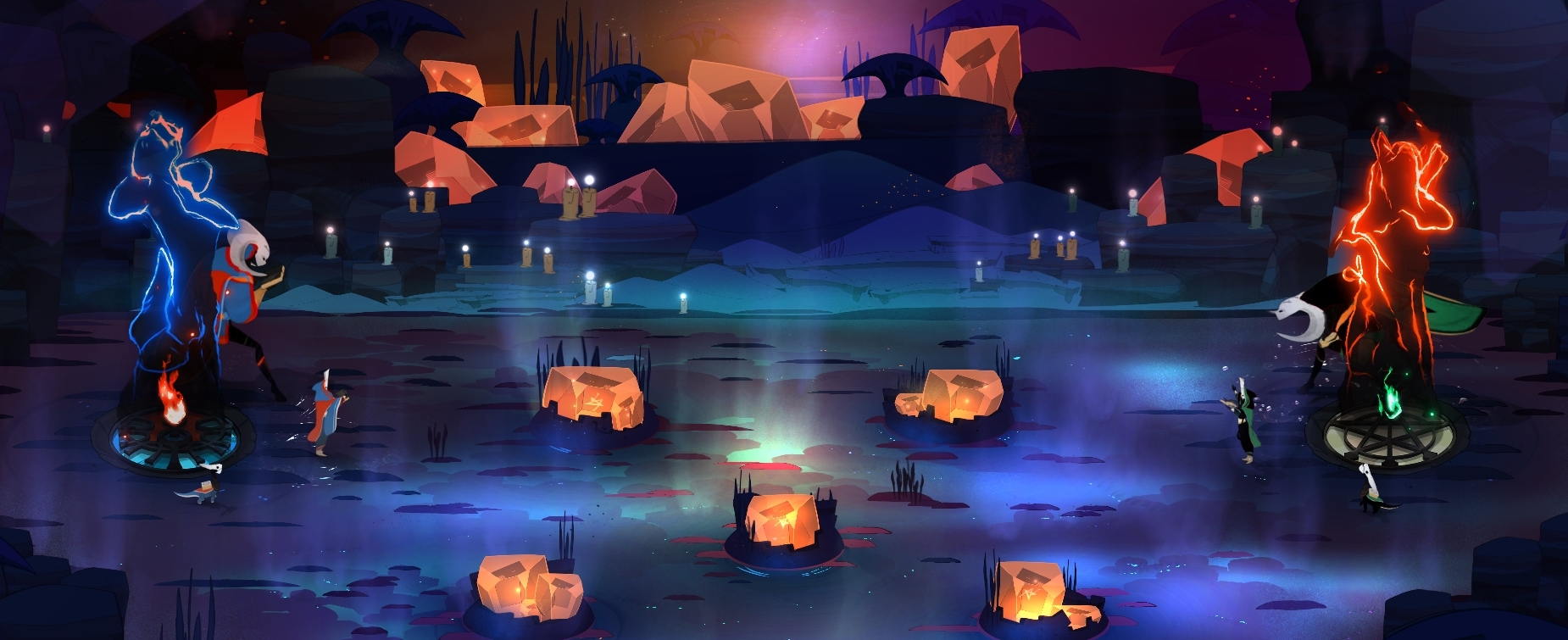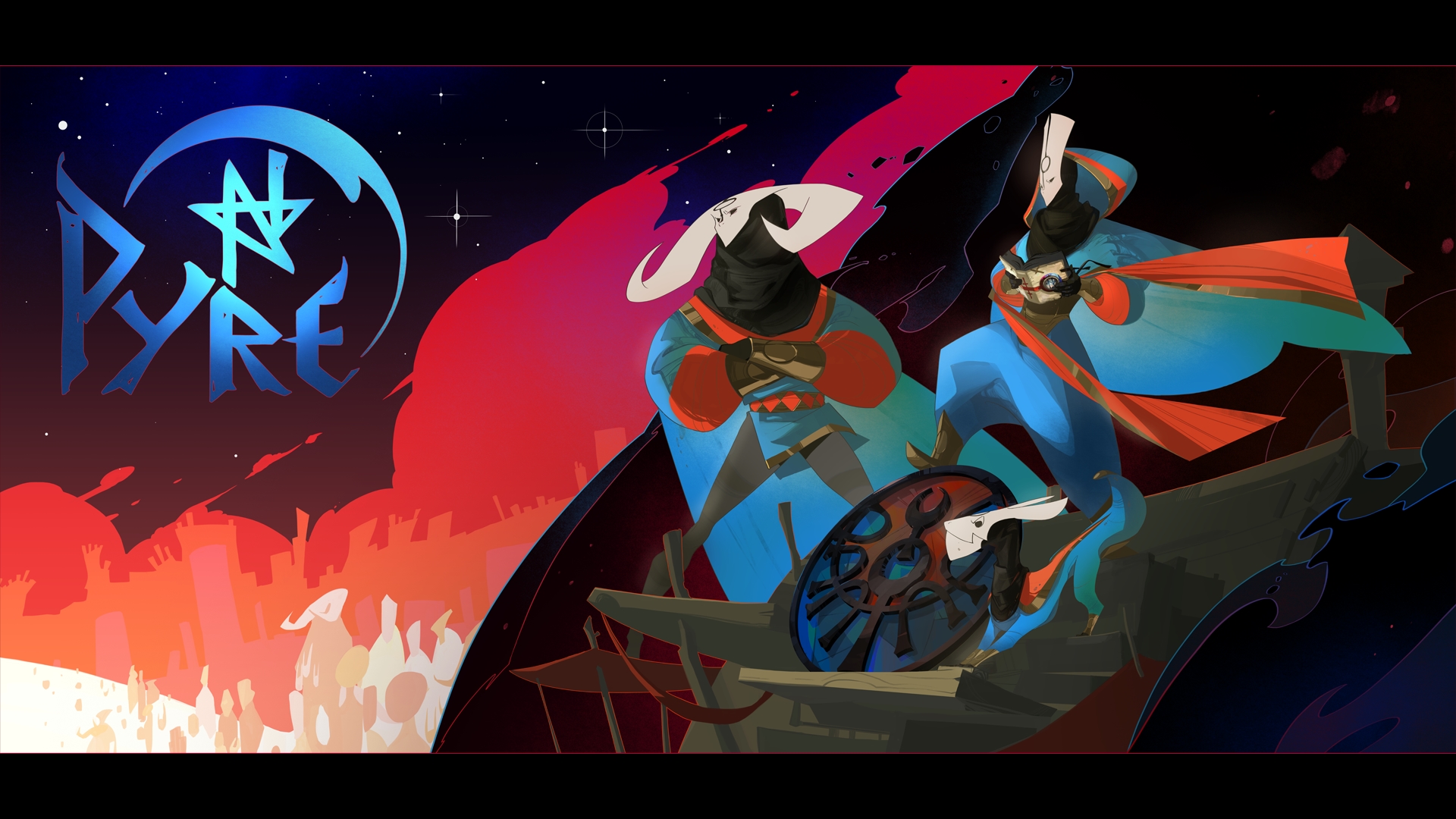Pyre, developed by Supergiant Games, follows in a line of unique titles such as Bastion and Transistor. Each Supergiant game is different than the last and Pyre is no exception. Part visual novel, part fantasy sports game, Pyre is a mashup of two unlikely genres that work way better than one could have ever expected.
Before going any further, it’s worth noting that I will be talking about a mechanic and story theme in Pyre that is key to spirit of the game, but doesn’t appear until a few hours in. If you consider this a spoiler, stop reading now. Know that Pyre is completely worth your time and money, and enjoy the game. Personally, I knew about this mechanic and story beat before purchasing the game, and it did not hinder my enjoyment whatsoever.
The game casts you as the Reader, a person that illegally held the power of literacy in a place called the Commonwealth. You never see the Commonwealth, you only ever hear of it from the people you meet and the conversations you have with them. From what they – and you – describe, it’s a place of a religious dictatorship. People are cast out into the Downside, where the game takes place, for transgressions against the government. Some of these are severe, such as a military deserter, others are plain silly, the person was simply there at the wrong place at the wrong time.

As a Reader though, you have access to the Books, which tell you of the Rites. The Rites are a sacred religious competition through which someone can earn their freedom and return to the Commonwealth. So when a trio of bandit looking fellows pick you up, they believe you’re their ticket to freedom.
The Rites play out as a three on three sports game. The goal is to cast the orb into the opposing team’s pyre, bringing their score to zero. You can only control one team member at a time though, you must manage your positions, create openings, all while not leaving yourself completely defenseless. Things start out simply enough, but as the game continues, things change. Your roster grows, you gain access to modifiers through talismans, so the Rites become more challenging, and therefore fulfilling as time goes on.
While the Rites could be considered the main source of combat in the game, they certainly aren’t the only thing you’re doing. The visual novel portion of the game is a significant one. It’s where the entire story takes place, you meet new people, take on more travelers, and train them in the ways of the Rites. As you travel across the colorful and pop-up book landscape of the Downside, you’ll meet people of various walks of life. The conversations you have with them can lead to stat increases for your party members, or a lucky trinket that will serve you well in the coming Rite.
But most importantly, the conversations will simply allow you to better know your companions. You’re all out in the Downside for one reason for another and you find solace in that fact. The characters are extremely well written, easily among the best I’ve seen in quite some time. Not all hit the high mark, but that’ll be based on personal preference. For me, characters like Sir Gilman brought some levity to the grim nature of Pyre, but he was otherwise of little consequence. Yet characters like Jodariel, who seem cold and steely on the outside, reveal themselves to be warm and caring. She’s the group mother, and cared more for anyone than she ever let on.

Even those who seem to be a nuisance at first, such as the snake witch Bertrude, will surprise you. As the story progresses, you’ll become privy to conversations between your companions. One between Bertude and the tree spy Volfred is of particular note, and gave me a new perspective on each of them.
The reason a lot of this character development matters is not only because of the story, but because eventually, these characters will leave you. See, the thing you don’t learn at first is that the Rites, when completed, will only take one person from the winning team and send them home. So over the course of several hours, you will get to know and care about these characters, only to have to let them go if you succeed.
The final Rite (known as the Liberation Rite), perfectly scored by a vocal track from Darren Korb and Ashley Barrett, are some of the most poetic moments in the game. When I approached my first one, everyone was solemn, knowing that a friend of theirs would leave them forever. The choice was difficult for me. I’d grown attached to many of these characters, especially the first four that you meet. Ultimately, I chose Hedwyn, for he was the first character I saw in the game. Flanked by his original companions, Jodariel and Rukey, it was a bittersweet moment. Here were friends working together in order to send one of their own home again.
The moments after are of quiet grief. It’s a testament to the writing and characterization that you feel what the characters are going through. You understand the absence they feel, for now you realize that this character you’ve talked with for several hours is now gone forever. You could have chosen someone else, and had that person remain, but your companions must be a certain “level” in order to be liberated, so your choices are limited. They tend to be those you’ve spent the most time with.

Pyre’s story isn’t its only thing it has going for it though. Alongside every other Supergiant game, the visuals are stunning. The landscape of the Downside is as colorful as it is dangerous. Everything from the way the little wagon drives over the desert, to how fluid your companions move while competing in the Rites is polished and fun to look at.
The music this time around is a strange one. The vocals by Darren Korb and many of the instrumental tracks are just as good as previous games. But the style is different. Because you face off against multiple teams during the game, each has their own distinct theme, and not all of them fit. The weird metal that comes on when facing the Dissidents is funny when you consider that the team leader Barker has no bite, but it doesn’t do much else. That said, the theme for the Liberation Rite is the star of the score, and never fails to make me feel something.
If I were to nitpick something about Pyre, it would probably be the UI. The shop UI is a complete mess and frustrated me more times than I’d like to admit. There are also an obscene amount of prompts that could be trimmed. When a game finishes and you return to the overworld, I shouldn’t have to press X to recognize we’ve finished the game, and then X again in order to start moving again. Just combine the two. It doesn’t help that the game gives you a cursor, even when playing with a controller. It’s a slow moving one at that too.
These are but small nitpicks on what is an otherwise stunning game. Pyre deserves to be played by everyone who enjoys a good story that’s punctuated by meaningful and thoughtful gameplay. It’s one of the more complete packages I’ve seen in a long time and more than worth your time and money.
